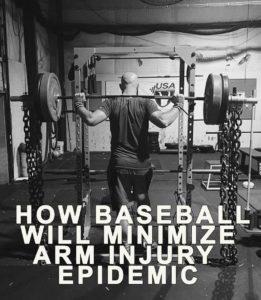 Baseball needs to start understanding the importance of biomechanics, human movement, strength and conditioning and nutrition. Period. I’m shocked about how little information and coaching is available to baseball athletes on how to improve their performance and reduce risk of baseball arm injury.
Baseball needs to start understanding the importance of biomechanics, human movement, strength and conditioning and nutrition. Period. I’m shocked about how little information and coaching is available to baseball athletes on how to improve their performance and reduce risk of baseball arm injury.
In my opinion, the answer to reducing many arm injuries in baseball is staring them right in the face. However, most coaches refuse to educate themselves on how the entire body is used to efficiently transfer energy to the ball and increase performance while reducing the risk of injury. I’m also shocked at how many high level pro athletes and D1 college athletes we have assessed and found significant breaks in their kinetic chain only to be told that nobody they have worked with has ever pointed these flaws out to them in their entire careers! Oftentimes they are fed information that only accelerates their problem.
For example, extreme throwing programs like extreme long toss and intense weighted ball programs (especially as their offseason training approach) neither of which work to address any of their biomechanics or weaknesses in their kinetic chains as athletes. It’s no wonder to me why baseball has a pattern of injury with shoulder and UCL tears. Throwing is glorified so much that very little time is spent addressing any of their deficiencies. More time needs to be spent developing healthy biomechanics and training to optimize the athlete through strength and conditioning, learning healthy movement patterns and practicing good nutrition.
Practicing Healthy Movement Prevents Baseball Arm Injury
Pitching isn’t some magic trick. There are answers and explanations to why athletes throw hard. There are also answers to why some pitchers throw hard and stay healthy and why some pitchers throw hard and get injured. In my opinion, the key is understanding the kinetic chain and how healthy human movement and strength and conditioning directly influence how the kinetic chain works on the mound. Let me explain, humans are masters of compensation and our movement patterns reveal breaks in our kinetic chains that will show up in your pitching mechanics on the mound. Dr. Kelly Starrett in his book Becoming a Supple Leopard says this about the importance of good movement for staying injury free. (1)
“It’s like this: Our bodies are set up to go through millions of movement cycles. Every time you squat, bend over, or walk in a compromised position, you’re burning through those cycles at an accelerated rate. Think of turning on and off the lights in your house. That light switch is set up for tens of thousands of cycles. Well, your body is set up for millions of cycles. Seriously, millions! So, by the time you’ve worn a hole in your kneecap, herniated your disk, or torn your labrum, chances are good that you’ve expended millions of cycles. In other words, your tissues and joints didn't just wear out; your body put up with your crappy positions and movements for the equivalent of millions of cycles. Everyone is different — genetics, training volume, and other lifestyle factors have a profound impact — but if you learn to move the way the body is designed to move, there’s less stress on the system, reducing the number of cycles you burn through.”
It is no different with pitching. A good kinetic chain will allow an athlete to transfer energy efficiently through the body resulting in optimized performance and the least amount of wear and tear on the body. So, we can assess an athletes poor movement patterns through an evaluation and then see where the poor movements show up in our 3x biomechanics analysis. Some athletes throw hard in poor movement patterns and some are restricted by their poor movement. Regardless, if you don’t work to correct your deficiencies you will never maximize your performance and you will burn through your joints at an accelerated rate which will eventually lead to baseball arm injury.
Strength Training and Nutrition Enhances Performance and Prevents Baseball Arm Injury
Strength and conditioning and nutrition are tied in when we begin to understand how to maximize power through good movement patterns (poor movements get exposed in the weight room) and how strength and muscle mass work to help stabilize your joints helping to minimize the risk of Baseball Arm Injury. We measure athletes athleticism by testing their vertical jump, broad jump and 10 yard dash to get an understanding of how much power they can potentially put through their kinetic chain. For example, with over 200 athletes we measured through our camp we found a direct correlation to pitching velocity linked to higher vertical jumps, farther broad jumps, faster 10 yd dashes and higher body weights. Similar results can be found in other studies. In a study by Graeme Lehman called, Correlation of Throwing Velocity to the Results of Lower-Body Field Tests in Male College Baseball Players they found that, (2)
“Increased body weight increases the total amount of energy that can be ultimately transferred to the ball allowing for higher throwing velocity. In each case that body weight was a substantial factor it was also coupled with the lateral to medial jump which indicates increased amounts of body mass must be accompanied by the appropriate amounts of power.”
This makes sense when we apply the Harman formula.
Harman formula: Peak power (W) = 61.9 x jump height (cm) + 36.0 x body mass (kg) + 1,822.
You can take an athlete’s vertical jump and body weight through the formula and find their peak power in watts. This gives us an idea of how much force an athlete’s lower half can create and if their kinetic chain is efficient they can potentially transfer that force into throwing velocity. We’ve found that high velocity pitchers produce around 10,000 to 11,000 watts. Most athletes we work with come nowhere close to that amount of force production and need to develop much more force through their lower half in order to optimize their kinetic chain. We influence force production with an olympic lifting based strength and conditioning program and individualized nutrition plans to support the training and build muscle mass. A good training program and nutrition plan are monumental to building a bigger, faster, stronger athlete which will help enhance performance and keep you healthy.
How You Move in the Weight Room Influences How You Move on the Mound
Training in the weight room drastically exposes breaks in your kinetic chain. One of many examples is a full depth olympic squat. It requires adequate ankle dorsiflexion, hip internal/external rotation, hip flexion, core strength/stability, and thoracic spine mobility. That is just one exercise of many that expose poor movement patterns! The weight room is your lab to improve your kinetic chain and maximize the amount of power you can produce through it. If an athlete struggles with the movements in the weight room I guarantee you the same problems will show up on the mound. So, you need to understand that the weight room directly correlates with your mechanics on the mound. Thus enhancing performance and minimizing risk of baseball arm injury.
Furthermore, skeletal muscle plays a huge role in keeping your joints and body healthy. In a study called, Muscle as a Molecular Machine for Protecting Joints and Bones by Absorbing Mechanical Impacts by Arman Sarvazyan they found that skeletal muscle helps absorb and redistribute energy to unload the joints and minimize the risk of baseball arm injury. Here is an excerpt: (3)
“Ability of muscle to redistribute the energy of impact in time and space and unload skeletal joints is of key importance in physical activities, such as running, playing basketball and soccer,jumping and wrestling. The ability of skeletal muscles to eliminate harmful effects of mechanical shocks has been created by biological evolution to allow the living species to move from the ocean to the earth, to enable the appearance of animals capable of running, jumping, hunting and fighting.”
In another study called, Resistance Training: Health Benefits and Recommendations by Nobuko Hongu they discussed how strength training not only helped athletes perform better and keep them healthy, but how it is very important for the general population to stay healthy and fight disease. Here is an excerpt from the study: (4)
“Resistance training can be effective in the development of muscular strength, muscular endurance, and muscular mass, in a broad range of people, including women and older adults. As older adults age, they lose muscle mass and quality (less strength for the same muscle mass), a condition known as sarcopenia. Resistance training can help slow down the loss of muscle mass by continually rebuilding muscles. Resistance training also enhances muscle strength, which protects joints and improves stability and balance, reducing the risk of falls.”
To quote one of my favorite strength and conditioning and movement specialists Dr. Trevor Bachmeyer, “Want to build a giant stone wall against f****** disease? Against decay? Against illness? Become as fit as humanly possible.”
The Problem with Extreme Throwing and Strength Training
The problem is most approaches want to marry the extreme throwing and strength training together or they fail at individualizing an athlete’s offseason approach to work on their specific deficiencies. Marrying extreme throwing with an intense offseason lifting program is contraindicative. Here is why: Baseball has a pattern of injury with UCL and shoulder injuries. Dr. James Andrews and Dr. Glenn Fleisig at ASMI conclude that the three biggest causes of injury in throwing are overuse, poor mechanics and poor physical fitness. They recommend pitchers need to take at least four months of the year off from throwing. Four months is a typical offseason, but when your offseason approach consists of extreme throwing you are creeping into one of the biggest causes of injury, overuse. Poor physical fitness is another huge cause of baseball arm injury. Pitchers tend to have weak upper bodies specifically overhead because conventional wisdom says lifting overhead is bad for pitchers. However, a good offseason strength and conditioning program needs to develop strength overhead as it is huge to keeping the athlete healthy through a season. When you combine overhead lifting and excessive throwing it creates unreasonable fatigue that can potentially lead to injury. Unfortunately, we have seen it many times with guys in our program trying to combine our offseason lifting with extreme throwing.
The Patterns of Injury Will Continue Unless We Adapt Our Training
In my opinion, as long as baseball continues to glorify extreme throwing and ignore how the biomechanics, strength and conditioning, healthy human movement and nutrition blend together to build the athlete we will continue to see a pattern of injury in baseball. I understand it is hard to learn and implement this approach, but players owe it to themselves to maximize their potential and coaches owe it to their players to give them the best chance to excel in this game. Developing the athlete and advancing the biomechanics will not only enhance performance it will build a human machine capable of protecting against baseball arm injury.
The #1 Training Program To Develop the Healthy Pitcher
 Not only has this program helped tons of pitchers live the dream of throwing 90+mph and signing with a D1 University, getting drafted by a Major League Organization and making it back to Major League Baseball but it has rebuilt careers plagued by injury. Many scouts in all organizations of baseball have recommended this program to not only help young pitchers get to the 90+mph range to improve their value at the next level but to overcome injury or prevent further arm pain.
Not only has this program helped tons of pitchers live the dream of throwing 90+mph and signing with a D1 University, getting drafted by a Major League Organization and making it back to Major League Baseball but it has rebuilt careers plagued by injury. Many scouts in all organizations of baseball have recommended this program to not only help young pitchers get to the 90+mph range to improve their value at the next level but to overcome injury or prevent further arm pain.
The reason the 3X Extreme Pitching Velocity Program works is because it is based off of science and it has been proven to develop the healthy 90+mph fastball on thousands of pitchers. It isn't rocket science or voodoo, it is the real deal! The program comes with a high level workload of drills, lifts and exercises scientifically programmed to enhance throwing speed on the mound while developing an efficient healthy pitching delivery. The format of the 3X Pitching Velocity Program is similar to the same approach Olympic throwers have been using for decades to increase throwing velocity and reduce wear and tear. This approach isn't new to the sports world but it is new to baseball.
If you are serious about your career and are insanely driven to put yourself into an extremely small percentage of pitchers who are potential D1 prospects, top level draft picks or you just want to reach your potential on the mound then this program is the best chance you have to making your dreams come true.
Learn more about the 3X Extreme Pitching Velocity Program or get started TODAY adding 5-10+mph!

Works Cited
- Starrett, Kelly, and Glen Cordoza. Becoming a Supple Leopard: The Ultimate Guide to Resolving Pain, Preventing Injury, and Optimizing Athletic Performance. N.p.: n.p., n.d. Print.
- Lehman, Graeme, Eric J. Drinkwater, and David G. Behm. “Correlation of throwing velocity to the results of lower-body field tests in male college baseball players.” The Journal of Strength & Conditioning Research 27.4 (2013): 902-908.
- Sarvazyan, Armen, et al. "Muscle as a molecular machine for protecting joints and bones by absorbing mechanical impacts." Medical hypotheses 83.1 (2014): 6-10.
- Hongu, Nobuko, et al. "Resistance training: Health benefits and recommendations." College of Agriculture and Life Sciences Cooperative Extension (2012).


Trackbacks/Pingbacks